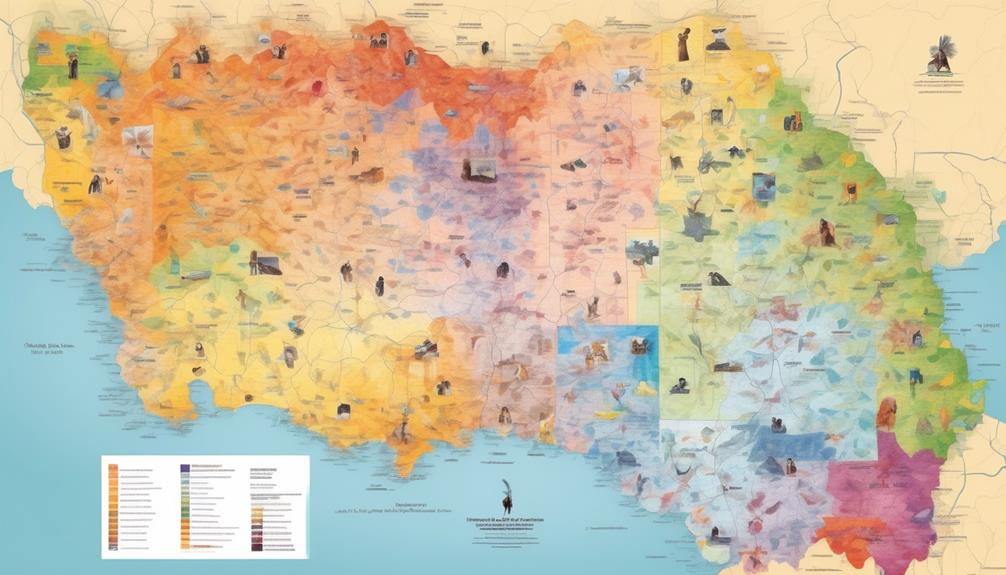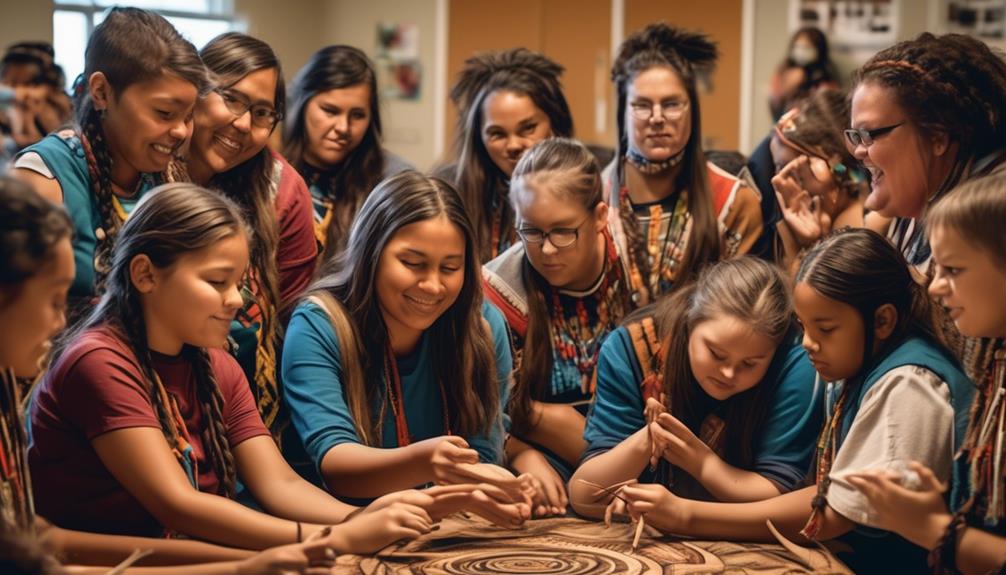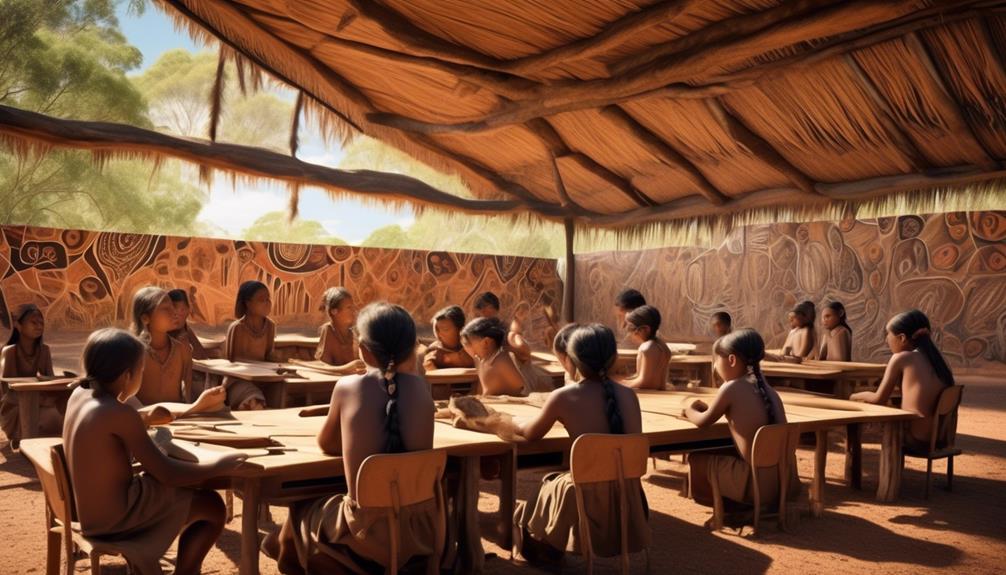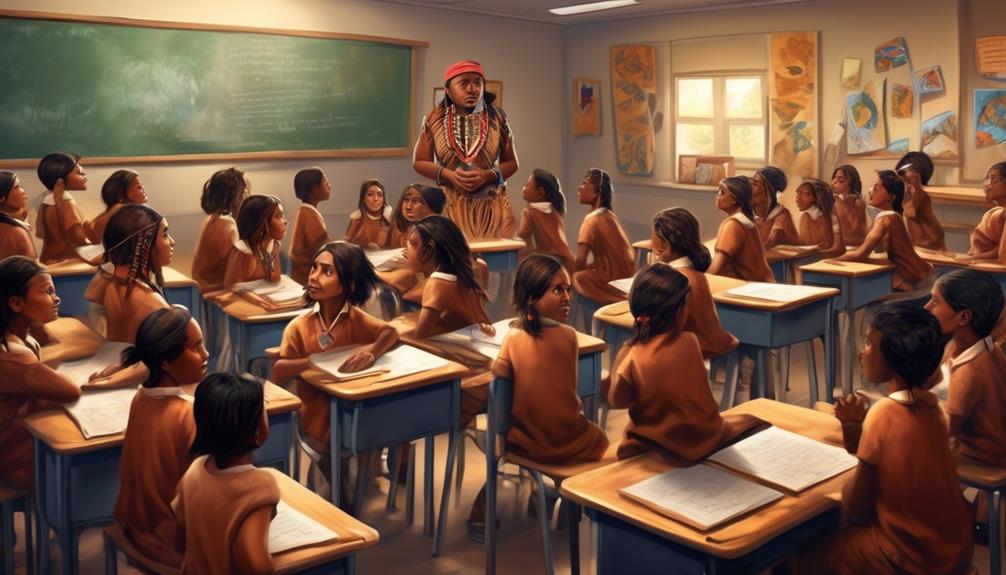By chance, the research on Indigenous education in the Northern Territory has uncovered crucial insights into the challenges faced by Indigenous students in the region. These findings have sparked valuable discussions and prompted policy changes aimed at reducing educational disparities and improving the academic success of Indigenous students.
As we delve into the key findings and recommendations of the review, it becomes evident that the impact of this review extends far beyond the Northern Territory, influencing future education policies and initiatives.
Key Takeaways
- Low literacy and numeracy outcomes for remote Indigenous students
- Urgent need for targeted initiatives and resources
- Importance of addressing educational disparities and developing meaningful partnerships with Indigenous communities
- Tailoring interventions to understand the unique needs of Indigenous students
Overview of Indigenous Education
We frequently encounter challenges in Indigenous education, particularly in remote areas where low literacy and numeracy outcomes persist among students. The 2013 review of Indigenous education in the Northern Territory highlighted the concerning educational outcomes for remote Indigenous students. In response, the Northern Territory Department of Education committed significant resources to improve Indigenous education. This commitment led to the development of a 10-year Indigenous Education Strategy aimed at addressing the review's recommendations.
The Strategy focuses on closing the gap in educational achievement for Indigenous students and includes targeted interventions to support their aspirations. One of the key aspects emphasized in the review was the need for meaningful partnerships with Indigenous communities. These partnerships are crucial for understanding the unique cultural and educational needs of Indigenous students and for implementing effective strategies to improve their educational outcomes.
Furthermore, the review emphasized the importance of data improvements to monitor the progress of Indigenous education initiatives. By actively engaging with Indigenous communities and working collaboratively to implement the recommendations of the review, we can strive to create a more equitable and supportive educational environment for Indigenous students in the Northern Territory.
Key Findings of the Review

The review of Indigenous education in the Northern Territory revealed significant disparities in literacy and numeracy outcomes for remote Indigenous students. This independent review of Indigenous educational outcomes in the Northern Territory highlighted the following key findings:
- Low Literacy and Numeracy Outcomes: The review found that literacy and numeracy outcomes of remote Indigenous students are significantly below both non-Indigenous students and Indigenous students in other jurisdictions.
- Focus on Improvement: The Indigenous Education Strategy, implemented by the Department of Education, emphasizes the need to improve educational outcomes for Indigenous students in the Northern Territory.
- Urgent Need for Improvement: The outcomes of the review underscore the pressing need for targeted initiatives and resources to address the educational disparities faced by remote Indigenous students.
- Call for Action: The review's findings serve as a clarion call for all stakeholders to come together and work towards meaningful, sustainable improvements in Indigenous education in the Northern Territory.
These findings underscore the critical importance of addressing the educational disparities faced by Indigenous students and highlight the urgent need for focused and collaborative efforts to improve educational outcomes in remote Indigenous communities.
Challenges Faced by Indigenous Students
Despite significant efforts to address educational disparities, Indigenous students in the Northern Territory continue to face pronounced challenges in literacy and numeracy outcomes, especially in remote areas. The Territory Department of Education, in partnership with Indigenous communities, is actively working to address the issues affecting educational outcomes for Indigenous students. The aspirations of Indigenous parents for their children's education are high, yet the reality presents a challenge for the Northern Territory.
One of the primary obstacles is the disparity in literacy and numeracy outcomes between Indigenous and non-Indigenous students. This gap is particularly pronounced in remote areas, where access to quality education and resources is limited. Additionally, data deficiencies hinder accurate assessment of Indigenous educational outcomes, making it difficult to measure progress and tailor interventions effectively.
To improve educational outcomes for Indigenous students, targeted interventions and support are crucial. The implementation of the Indigenous Education Strategy represents a significant step towards addressing these challenges. However, there's still much work to be done in ensuring that all Indigenous students in the Northern Territory have access to quality education and the opportunity to reach their full potential.
Recommendations for Improvement

Addressing the challenges faced by Indigenous students in the Northern Territory requires a focused approach to implementing targeted interventions and support to improve educational outcomes.
Based on our review of Indigenous education in the Northern Territory, we recommend the following improvements to better the educational aspirations of Indigenous children:
- Develop Meaningful Partnerships: Establish genuine partnerships with Indigenous people to ensure that their voices are heard and their perspectives are integrated into the design and delivery of education programs.
- Enhance Parent and Community Involvement: Encourage the active involvement and ownership of Indigenous parents and communities in the education of their children, fostering a sense of shared responsibility for educational outcomes.
- Prioritize Funding and Resource Allocation: Allocate adequate funding and resources specifically for Indigenous education to address the disparities and provide necessary support for improving educational outcomes.
- Promote Reliable Data Collection and Community Participation: Implement reliable data collection methods and prioritize community participation to understand the unique needs of Indigenous students and tailor interventions accordingly.
These recommendations are essential for establishing a collaborative approach to education, empowering Indigenous communities, and ultimately improving educational outcomes for Indigenous children in the Northern Territory.
Impact on Future Education Policies
Collaboration between government agencies and educational institutions is crucial for shaping future education policies that address the low literacy and numeracy outcomes of remote Indigenous students in the Northern Territory. The recent review found that the Indigenous Education Strategy, a 10-year plan, aims to implement recommendations to improve outcomes for Indigenous students. This strategy aligns with national efforts to improve Indigenous education and includes targeted interventions and support for Indigenous students. However, to accurately assess outcomes and inform future education policies, data deficiencies in Indigenous education need to be addressed. This collaboration is essential for implementing the Indigenous Education Strategy and closing the gap in educational achievement. Furthermore, involving Indigenous parents and the community in the education and training of their children is vital for the success of future policies. It is imperative that the Department works closely with Indigenous communities to ensure that the policies are culturally appropriate and effective.
| Challenges | Solutions |
|---|---|
| Low literacy and numeracy outcomes for remote Indigenous students | Implementation of targeted interventions and support |
| Data deficiencies in Indigenous education | Addressing data deficiencies to accurately assess outcomes |
| Involving Indigenous parents and community in education and training | Collaborating with Indigenous communities for culturally appropriate policies |
Frequently Asked Questions
What Is the Education in the Northern Territory?
In the Northern Territory, Indigenous participation in education is crucial. We prioritize cultural integration, language preservation, and community involvement to support students.
Our focus is on providing educational resources, student support, and curriculum development to ensure that Indigenous students have equal opportunities for success.
We believe that by working together and addressing these areas, we can create a more inclusive and supportive educational environment for all students.
How Effective Was the Northern Territory Intervention?
We've seen the impact of the Northern Territory Intervention on Indigenous education. While it aimed to improve outcomes, the review found low literacy and numeracy levels for remote Indigenous students.
To enhance effectiveness, community engagement and cultural integration are crucial. Supporting programs and educational resources are vital for better outcomes.
Improved data collection will help monitor progress. Collaborative efforts between government and the education sector are key to closing the achievement gap.
Has the NT INTerveNTion Ended?
Yes, the NT intervention has ended.
We are now assessing its impact on the community.
In addition, we are providing ongoing support and empowerment to the community.
Our focus is on cultural connection and education outcomes.
We believe that by improving these aspects, we can enhance future prospects.
What Is the Indigenous Strategy of the Northern Territory?
Our Indigenous strategy in the Northern Territory prioritizes Indigenous engagement, cultural inclusion, community empowerment, and educational equity.
We focus on preserving traditional knowledge, strengthening language acquisition, and fostering a connection to the land.
The strategy aligns with national efforts to improve Indigenous education and emphasizes the importance of meaningful partnerships with Indigenous communities.
It addresses key issues affecting educational outcomes for Indigenous children, and we're committed to implementing the strategy collaboratively.
Conclusion
In conclusion, the review of Indigenous education in the Northern Territory highlights the urgent need to address the educational disparities faced by Indigenous students. The findings point to a roadblock in the journey towards educational equity.
With the development of a 10-year Indigenous Education Strategy, we hope to pave a new path forward, breaking down barriers and building bridges to success for Indigenous students.
It's time to turn the page and write a new chapter in Indigenous education.









